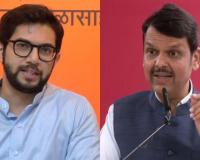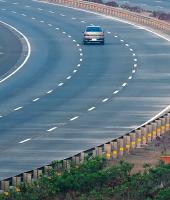- Editorial
- The Human and Economic Cost of Maharashtra's Worst Monsoon in History!
The Human and Economic Cost of Maharashtra's Worst Monsoon in History!
On

By Ansari Aejaz Ahmed
Maharashtra has endured one of the most catastrophic monsoon seasons in its recorded history, with unprecedented rainfall and floods claiming 337 lives and destroying crops across 68.69 lakh hectares between May and September 2025.
The calamity affected 29 of the state’s 36 districts with 282 talukas bearing the brunt of nature’s fury, offering a grim testament to the state’s vulnerability to extreme weather events.
Official reports submitted by district collectors to the Disaster, Relief and Rehabilitation Department confirmed that rain-related incidents including floods, drowning, lightning strikes, wall collapses and landslides claimed these 337 lives during the kharif season, representing one of the highest monsoon death tolls in Maharashtra’s recent history.
The human tragedy spread across Maharashtra’s diverse geographical regions, with lightning strikes emerging as a particularly deadly phenomenon, accounting for approximately 70 victims or nearly 20 percent of total fatalities. Most lightning casualties occurred in Marathwada, Vidarbha and North Maharashtra, regions situated between the Satpuda and Sahyadri ranges where atmospheric conditions foster severe electrical storms.
The human tragedy spread across Maharashtra’s diverse geographical regions, with lightning strikes emerging as a particularly deadly phenomenon, accounting for approximately 70 victims or nearly 20 percent of total fatalities. Most lightning casualties occurred in Marathwada, Vidarbha and North Maharashtra, regions situated between the Satpuda and Sahyadri ranges where atmospheric conditions foster severe electrical storms.
The Marathwada region, comprising eight districts, recorded 104 deaths between June 1 and September 29, 2025, marking the highest regional toll in a decade. This historically drought-prone area experienced a cruel irony as excessive rainfall transformed parched fields into submerged landscapes, with Nanded district alone reporting 28 deaths. Vidarbha recorded 16 fatalities in rain-related incidents during an intense 10-day spell that inundated Nagpur, Wardha, Gondia, Bhandara, Gadchiroli and Chandrapur. Western Maharashtra also witnessed multiple casualties, with Solapur, Pune, Satara and Kolhapur districts particularly affected, including 28 deaths in the Pune division during the devastating August floods. The Konkan coastal belt recorded three deaths across Raigad, Ratnagiri and Sindhudurg districts.
The floods delivered a massive blow to Maharashtra’s agricultural sector, with crops on 68.69 lakh hectares completely destroyed out of the total 1.43 crore hectares sown during the monsoon, representing nearly half of the state’s kharif cultivation. Marathwada emerged as the worst-affected region with over 18 lakh hectares of farmland damaged. The scale of destruction varied across districts, with Dharashiv witnessing damage to 4.49 lakh hectares across 737 villages, Nanded losing 2.62 lakh hectares, Hingoli seeing 1.24 lakh hectares affected and Beed suffering losses exceeding 1 lakh hectares. Over 3,960 villages in Marathwada were directly impacted, affecting more than 16 lakh farmers whose entire year’s labour was wiped out. Vidarbha reported damage to 20,854 hectares of agricultural land, with 29,920 farmers affected, particularly those cultivating cotton and soybean. Western Maharashtra saw extensive crop losses over 57,000 hectares in Pune, Solapur, Satara and Sangli districts, while North Maharashtra reported 16,985 hectares of damage, mainly in Jalgaon and Nashik, including over 6,100 hectares of banana cultivation in Jalgaon alone.
Beyond immediate crop destruction, an alarming 60,000 hectares of farmland suffered complete topsoil washout, posing a long-term threat to soil fertility and future productivity. The floods also exacted a heavy toll on livestock, with 5,085 milch animals, 4,390 other cattle and 1,87,498 poultry birds perishing during the monsoon. Regional losses included Marathwada’s 2,838 animals and Western Maharashtra’s 7,847 cattle and bovine deaths, with reports indicating that over one lakh livestock belonging to 1,338 farmers across 12 districts were lost due to flooding.
Infrastructure damage was equally severe, with 2,159 houses completely destroyed and 42,622 partially damaged. Additionally, 148 kutcha homes in hilly areas were damaged, 1,370 shops reduced to rubble, 519 huts destroyed and 1,902 cattle sheds adjacent to homes damaged. Kolhapur district alone reported inundation of eight state highways, 34 major district roads and 79 barrages, cutting off villages from market access and emergency services. Massive evacuation operations were conducted across the state, with more than 41,000 people moved from vulnerable zones, including 40,882 from Kolhapur alone. Rescue operations involved coordinated efforts by the National Disaster Response Force, State Disaster Response Force, Indian Army, Indian Air Force and local authorities operating under extreme conditions. The State Emergency Operations Centre issued over 350 million alert messages via the Sachet app within 24 hours, while 8.4 crore SMS alerts were sent during the peak flood period.
The unprecedented rainfall caused major dams and reservoirs to reach full capacity, forcing large-scale water releases that worsened downstream flooding. The most dramatic discharge occurred at Jayakwadi Dam in Chhatrapati Sambhajinagar, which released a record three lakh cusecs of water, inundating Paithan and surrounding areas. Majalgaon Dam in Beed discharged 1.15 lakh cusecs into the Godavari, while Bhatsa Dam in Thane opened its gates to regulate rising levels.
The unprecedented rainfall caused major dams and reservoirs to reach full capacity, forcing large-scale water releases that worsened downstream flooding. The most dramatic discharge occurred at Jayakwadi Dam in Chhatrapati Sambhajinagar, which released a record three lakh cusecs of water, inundating Paithan and surrounding areas. Majalgaon Dam in Beed discharged 1.15 lakh cusecs into the Godavari, while Bhatsa Dam in Thane opened its gates to regulate rising levels.
Although not included in the official flood death toll of 337, Maharashtra continues to grapple with a deepening farmer suicide crisis that intensified through 2025. Between January and March 2025 alone, 767 farmers died by suicide, averaging one every three hours. By June, the number had risen to 822, making Maharashtra the epicentre of India’s agrarian distress. Marathwada recorded 520 farmer suicides between January and June 2025 — a 20 percent increase from 430 cases in the same period last year — with Beed district topping the list at 126 suicides during the first half of 2025.
On October 7, 2025, Chief Minister Devendra Fadnavis announced a comprehensive relief package of ₹31,628 crore for farmers affected by floods and heavy rains, described as the largest in the state’s history. The compensation structure provides ₹18,500 per hectare for rain-fed crops, ₹27,000 per hectare for irrigated land, ₹32,500 per hectare for horticulture and orchard farmers, and an additional ₹10,000 per hectare for seeds and fertilisers for the upcoming rabi season. For soil restoration, the package includes ₹47,000 in cash per hectare where topsoil was completely eroded, plus ₹3 lakh per hectare through the MGNREGA scheme for rehabilitation. Livestock compensation has been fixed at ₹32,000 per animal death, expanding earlier NDRF norms that limited aid to three animals per family. Infrastructure support includes ₹30,000 for each damaged well, ₹50,000 relief for shop owners, assistance under PM Awas Yojana for damaged houses, ₹10,000 crore for rural infrastructure restoration and ₹1,500 crore through the District Planning and Development Council fund. Approximately 45 lakh insured farmers will receive enhanced payouts of ₹35,000 per hectare for non-irrigated land and ₹50,000 per hectare for irrigated land.
The relief package covers 29 districts and 282 talukas across 2,059 revenue circles. The government has committed to disbursing the assistance before Diwali 2025 through direct benefit transfers to farmers’ bank accounts. However, farmer unions, agricultural activists and opposition parties have criticised the package, alleging that only ₹6,500 crore constitutes new financial assistance, while the remainder comprises insurance settlements and MGNREGA allocations already due to farmers.
The relief package covers 29 districts and 282 talukas across 2,059 revenue circles. The government has committed to disbursing the assistance before Diwali 2025 through direct benefit transfers to farmers’ bank accounts. However, farmer unions, agricultural activists and opposition parties have criticised the package, alleging that only ₹6,500 crore constitutes new financial assistance, while the remainder comprises insurance settlements and MGNREGA allocations already due to farmers.
Opposition parties including Congress and Shiv Sena (UBT) demanded that the government declare a “wet drought,” though the administration clarified that such a term is not recognised under existing disaster management protocols. Maharashtra Congress president Harshvardhan Sapkal demanded immediate relief of ₹50,000 per hectare for all affected farmers and ₹5 lakh per hectare for those whose land was completely destroyed, while Shiv Sena (UBT) chief Uddhav Thackeray urged the Centre to sanction a ₹10,000 crore special package specifically for Marathwada.
Meteorologically, Maharashtra recorded 996.7 mm of rainfall this monsoon, representing 103.57 percent of its seasonal average, with extreme regional variations. Dharashiv district alone received 147.9 percent of normal rainfall, with Bhum taluka recording 866 mm compared to its usual 562 mm. August saw the rare convergence of five weather systems simultaneously, leading to continuous heavy rainfall across multiple regions. Experts attributed the extreme conditions to a combination of factors including Indian Ocean warming, Pacific temperature variations influencing monsoon patterns and the formation of multiple low-pressure zones due to intensified wind activity.
On October 9, 2025, the Maharashtra government declared 253 talukas as flood-affected through a government resolution, revising the number to 282 talukas — 251 fully and 31 partially affected — on October 11, 2025. Over 90 talukas in Vidarbha alone were classified as flood-hit, with uniform compensation norms applied across all declared areas. Chief Minister Fadnavis, along with Deputy Chief Ministers Eknath Shinde and Ajit Pawar, has submitted a comprehensive memorandum to union Home Minister Amit Shah seeking additional assistance from the National Disaster Relief Fund, stating that state resources alone are insufficient to manage the scale of the catastrophe.
On October 9, 2025, the Maharashtra government declared 253 talukas as flood-affected through a government resolution, revising the number to 282 talukas — 251 fully and 31 partially affected — on October 11, 2025. Over 90 talukas in Vidarbha alone were classified as flood-hit, with uniform compensation norms applied across all declared areas. Chief Minister Fadnavis, along with Deputy Chief Ministers Eknath Shinde and Ajit Pawar, has submitted a comprehensive memorandum to union Home Minister Amit Shah seeking additional assistance from the National Disaster Relief Fund, stating that state resources alone are insufficient to manage the scale of the catastrophe.
000
About The Author
Latest News
03 Nov 2025 17:24:39
The Pune-Nashik highway was blocked by hundreds of angry local residents after a leopard killed a young boy in the...











